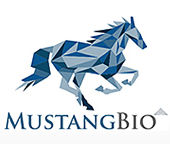预约演示
更新于:2025-10-25
MB-101 (Mustang)
更新于:2025-10-25
概要
基本信息
药物类型 通用型CAR-T |
别名 IL13Rα2-targeted CAR T cell therapy (Mustang Bio)、MB 101、MB-101 |
作用方式 激动剂、抑制剂 |
作用机制 4-1BB激动剂(肿瘤坏死因子受体超家族成员9激动剂)、CD19抑制剂(B淋巴细胞抗原CD19抑制剂)、IL-13Rα2抑制剂(白细胞介素-13受体α2亚基抑制剂) |
在研适应症 |
非在研适应症- |
非在研机构- |
最高研发阶段临床1期 |
首次获批日期- |
最高研发阶段(中国)- |
特殊审评孤儿药 (美国) |
登录后查看时间轴
关联
4
项与 MB-101 (Mustang) 相关的临床试验NCT04119024
Phase I Dose Escalation Study of Systemically Administered IL13Ra2 Chimeric Antigen Receptor (CAR) T Cells After a Nonmyeloablative Conditioning Regimen in Patients With Metastatic Melanoma and Other Solid Tumors
This phase I trial studies the side effects and best dose of modified immune cells (IL13Ralpha2 CAR T cells) after a chemotherapy conditioning regimen for the treatment of patients with stage IIIC or IV melanoma or solid tumors that have spread to other places in the body (metastatic). The study agent is called IL13Ralpha2 CAR T cells. T cells are a special type of white blood cell (immune cells) that have the ability to kill tumor cells. The T cells are obtained from the patient's own blood, grown in a laboratory, and modified by adding the IL13Ralpha2 CAR gene. The IL13Ralpha2 CAR gene is inserted into T cells with a virus called a lentivirus. The lentivirus allows cells to make the IL13Ralpha2 CAR protein. This CAR has been designed to bind to a protein on the surface of tumor cells called IL13Ralpha2. This study is being done to determine the dose at which the gene-modified immune cells are safe, how long the cells stay in the body, and if the cells are able to attack the cancer.
开始日期2025-10-07 |
申办/合作机构  Stanford University Stanford University [+4] |
NCT04661384
A Phase 1 Study to Evaluate IL13Rα2-Targeted Chimeric Antigen Receptor (CAR) T Cells for Adult Patients With Leptomeningeal Glioblastoma, Ependymoma or Medulloblastoma
This phase I trial investigates the side effects of brain tumor-specific immune cells (IL13Ralpha2-CAR T cells) in treating patients with leptomeningeal disease from glioblastoma, ependymoma, or medulloblastoma. Immune cells are part of the immune system and help the body fight infections and other diseases. Immune cells can be engineered to destroy brain tumor cells in the laboratory. IL13Ralpha2-CAR T cells is brain tumor specific and can enter and express its genes in immune cells. Giving IL13Ralpha2-CAR T cells may better recognize and destroy brain tumor cells in patients with leptomeningeal disease from glioblastoma, ependymoma or medulloblastoma.
开始日期2021-03-05 |
申办/合作机构 |
NCT04510051
Phase I Study of Cellular Immunotherapy Using Memory Enriched T Cells Lentivirally Transduced to Express an IL13Rα2-Targeting, Hinge-Optimized, 41BB-Costimulatory Chimeric Receptor and a Truncated CD19 for Children With Recurrent/Refractory Malignant Brain Tumors
This phase I trial investigates the side effects of chemotherapy and cellular immunotherapy in treating children with IL13Ralpha2 positive brain tumors that have come back after a period of improvement (recurrent) or do not respond to treatment (refractory). Cellular immunotherapy (IL13(EQ)BBzeta/CD19t+ T cells) are brain-tumor specific cells that may induce changes in body's immune system and may interfere with the ability of tumor cells to grow and spread. Chemotherapy drugs, such as as cyclophosphamide and fludarabine, work in different ways to stop the growth of tumor cells, either by killing the cells, by stopping them from dividing, or by stopping them from spreading. Many patients with brain tumor respond to treatment, but then the tumor starts to grow again. Giving chemotherapy in combination with cellular immunotherapy may kill more tumor cells and improve the outcome of treatment.
开始日期2020-12-04 |
申办/合作机构 |
100 项与 MB-101 (Mustang) 相关的临床结果
登录后查看更多信息
100 项与 MB-101 (Mustang) 相关的转化医学
登录后查看更多信息
100 项与 MB-101 (Mustang) 相关的专利(医药)
登录后查看更多信息
1
项与 MB-101 (Mustang) 相关的文献(医药)2015-08-01·3 Biotech4区 · 工程技术
Biosurfactant production from marine bacteria associated with sponge Callyspongia diffusa
4区 · 工程技术
Article
作者: Selvin, Joseph ; Kiran, Seghal ; Dhasayan, Asha
Marine-derived biosurfactants have gained significant attention due to their structural and functional diversity. Biosurfactant production was performed using bacteria associated with Callyspongia diffusa, a marine sponge inhabiting the southern coast of India. A total of 101 sponge-associated bacteria were isolated on different media, of which 29 isolates showed positive result for biosurfactant production. Among the 29 positive isolates, four were selected based on highest emusification activity and were identified based on 16S rDNA sequence analysis. These isolates were identified as Bacillus subtilis MB-7, Bacillus amyloliquefaciens MB-101, Halomonas sp. MB-30 and Alcaligenes sp. MB-I9. The 16S rDNA nucleotide sequences were deposited in GenBank with accession numbers KF493730, KJ540939, KJ414418 and KJ540940, respectively. Based on the highest oil displacement activity and effective surface tension reduction potential, the isolate B. amyloliquefaciens MB-101 was selected for further optimization and structural delineation. The production of biosurfactant by the isolate was significantly enhanced up to 6.76 g/l with optimal concentration values of 2.83 % for glycerol, 2.65 % for peptone, 20.11 mM for ferrous sulfate and 74 h of incubation by employing factorial design. The structural features of the purified biosurfactant from B. amyloliquefaciens MB-101 showed similarity with lipopeptide class of biosurfactant. In conclusion, the present study emphasizes the utilization of marine sponge-associated bacteria for the production of biosurfactant that may find various applications.
25
项与 MB-101 (Mustang) 相关的新闻(医药)2025-07-14
·今日头条
近日,
一款靶向 IL-13Rα2 的 CAR-T 疗法 ——MB-101,获美国食品药品监督管理局(FDA)授予孤儿药资格认定,用于复发性弥漫性间变性星形细胞瘤和胶质母细胞瘤(GBM)的治疗。
这款处于Ⅰ 期临床试验阶段的创新疗法,现有数据已展现出良好的耐受性,且 50% 的患者病情达到稳定或更好状态。早期临床中,仅接受 IL-13Rα2 靶向 CAR-T 细胞治疗的 “热肿瘤” 患者出现完全缓解,这一成果为该免疫治疗策略的潜在价值提供了有力佐证。
值得关注的是,MB-101 的进展并非个例。近年来,CAR-T 疗法在实体瘤领域持续发力,从脑瘤,到胃癌、肝癌、肺癌等,多项突破性成果不断涌现,正逐步打破实体瘤治疗的困境。这些进展不仅为像脑胶质瘤这样的难治性肿瘤患者带来了新生曙光,更标志着免疫细胞治疗在攻克实体瘤的道路上取得了突破性进展,未来可期!
▲截图源自“Targeted Oncology”
MB-101获美国FDA孤儿药认证:50%脑瘤患者病情稳定、疾病稳定最长达3.6年
弥漫性高级别胶质瘤(HGG)是神经肿瘤领域极具挑战性的难治性癌症,对包括最大限度手术切除、局部放疗及化疗在内的标准治疗(SOC)反应不佳。其中,胶质母细胞瘤(GBM)作为HGG中最具侵袭性的亚型,预后极差——即便接受强化SOC治疗,肿瘤复发仍不可避免且复发率极高。
近年来,嵌合抗原受体T细胞(CAR-T)疗法为改善HGG治疗结局带来新希望,早期临床试验已显现积极潜力:部分患者不仅生活质量(QOL)得到改善,更实现了客观缓解与显著生存获益。这一进展的核心在于精准靶点的选择——白介素13受体α2(IL-13Rα2)。作为一种睾丸癌抗原,IL-13Rα2在大多数HGG中高表达,尤其在GBM中与间充质基因特征及不良预后密切相关;更重要的是,其在正常脑组织中不表达的特性,使其成为CAR-T疗法的理想靶点。
近日被FDA授予孤儿药资格的这款MB-101产品,正是一款靶向IL-13Rα2的CAR-T疗法,全球知名期刊《自然・医学》报告了MB-101I期临床试验(NCT02208362)的振奋数据。该研究共纳入65例复发性高级别胶质瘤患者,接受至少一次CAR-T输注。
结果显示:该疗法在复发性高级别胶质瘤患者中展现出积极疗效与持久获益:
50%(29/58)的患者病情达到稳定或更好状态,最长疾病稳定持续时间超过1316天(≈3.6年)
;
22%(13/58)的患者实现至少90天的确诊疾病稳定
,进一步印证了疗效的持久性。
在生存数据方面,
所有患者中位总生存期(OS)为8个月
(详细下图a),
复发性胶质母细胞瘤(rGBM)亚组中位OS为7.7个月
(详见下图b)。
▲图源“Nat Med”,版权归原作者所有,如无意中侵犯了知识产权,请联系我们删除
具体疗效表现上,
2例患者(UPN165、UPN180)达到部分缓解,1例患者(UPN265)不仅实现完全缓解
,更在停止初始方案治疗后再次接受CAR-T周期治疗时达成第二次完全缓解。其中一例患者(UPN031)的情况值得广泛关注,经瘤内输注后,其复发的IL-13Rα2阳性GBM病变通过磁共振成像(MRI)清晰显示,
病变出现消退
(图2.5),直观验证了疗法的抗肿瘤活性。
▲图源“Nat Med”,版权归原作者所有,如无意中侵犯了知识产权,请联系我们删除
综上,从精准靶点的发现到临床试验的积极数据,局部区域输注靶向IL-13Rα2的CAR-T疗法MB-101在复发性高级别胶质瘤患者中展现出良好的安全性与临床疗效。这不仅为长期困于难治性脑胶质瘤的患者带来了切实希望,更标志着实体瘤CAR-T治疗从理论探索迈向临床获益的关键突破,为实体瘤的免疫治疗带来了新的曙光!
晚期食管癌治疗新突破!PD-1敲除MUC1靶向CAR-T助患者生存期突破24个月
《临床肿瘤学杂志》报道了一项针对晚期食管癌的创新疗法——“应用PD-1敲除MUC1靶向CAR-T细胞,治疗晚期食管癌的临床研究(NCT03706326)”。该研究共纳入9例IIIb~IV期食管癌/食管鳞状细胞癌患者,年龄范围为48~80岁,所有患者入组后均接受了至少一个周期的CAR-T细胞治疗。
结果显示:9例可评估疗效的患者中,
6例达到病情稳定(SD)
。值得关注的是,所有患者在输注后临床症状均显著改善;接受多周期输注的患者更表现出
长期稳定的疾病控制状态,其中2例患者总生存期(OS)达到24个月
,临床疗效显著。
总之,上述研究数据证实,PD-1基因敲除的MUC1靶向CAR-T细胞治疗晚期食管癌不仅安全性可靠,更能显著延长患者总生存期,为晚期食管癌患者带来了新的治疗希望。
▲截图源自“ASCO”
国研全球首个实体瘤CAR-T疗法satri-cel剑指胃癌,ORR超标准治疗5倍
2025年美国临床肿瘤学会(ASCO)大会上,全球首个拟用于实体瘤的CAR-T细胞疗法——舒瑞基奥仑赛注射液(satri-cel)的2期临床试验(CT041-ST-01)重磅数据公布,结果同步发表于权威期刊《柳叶刀》。
该研究共纳入156例患者,包括136例胃腺癌、20例胃食管连接部腺癌患者,随机分为两组:satri-cel组(即舒瑞基奥仑赛组,104例)、TPC组(即标准治疗对照组,52例)。
结果显示:经独立审查委员会评估,
satri-cel组疗效显著优于TPC组:确诊客观缓解率(ORR)为22%
(23/104,95%CI:15–31),
而TPC组仅为4%
(2/52,95%CI:0–13);
疾病控制率(DCR)方面,satri-cel组达63%
(95%CI:52–72),
TPC组仅为25%
(95%CI:14–39)。在生存获益上,
satri-cel组中位无进展生存期(PFS)为3.25个月
(95%CI:2.86–4.53),
显著长于TPC组的1.77个月
(95%CI:1.61–2.04)(详见下图);
中位总生存期(OS)为7.92个月
(95%CI:5.78–10.02),
较TPC组的5.49个月(95%CI:3.94–6.93)提升超30%
(详见下图)。
▲图源“The Lancet”,版权归原作者所有,如无意中侵犯了知识产权,请联系我们删除
值得关注的是,一例典型患者在输注satri-cel后第2周,肝脏病灶虽较基线增大,但
后续随访中逐渐缩小
,
至第26周时已小于基线水平
,直观体现了疗法的持续抗肿瘤活性。
▲图源“The Lancet”,版权归原作者所有,如无意中侵犯了知识产权,请联系我们删除
CAR-GPC3 T细胞疗法助肝癌患者,从快速进展到3年无癌生存
国际知名期刊《癌症通讯》报道了一则突破性案例:一名进展迅速的GPC3阳性肝细胞癌患者,经CAR-GPC3T细胞治疗后,实现超5年无病生存期及超8年总生存期,期间仅需口服抗乙肝病毒药物,未接受其他抗癌治疗。
此例幸运患者是一位54岁男性,既往有乙肝肝硬化病史,后确诊为Ib期肝细胞癌(HCC,肝功能Child-PughA级)。曾接受肿瘤切除术后6周复发,经1次肝动脉化疗栓塞术(TACE)、2次微波消融术(MWA)治疗后,磁共振成像(MRI)仍提示病情快速进展,出现肝脏多灶性病变、下腔静脉癌栓及腹膜后淋巴结转移,后续虽接受挽救性伽玛刀放疗(GKRS)、微波消融术(MWA)治疗,但效果不佳,随后入组临床试验接受CAR-GPC3T细胞输注。
结果显示:首次输注后2周,
腹膜后转移淋巴结开始缩小
(
短轴、长轴直径分别减小5.2%和4.5%
);最后一次输注后7天,
靶病灶短轴进一步缩小7.4%
。CAR-GPC3T细胞扩增至峰值时,
甲胎蛋白(AFP)从1301ng/mL降至565ng/mL,降幅达56.6%
,
患者7个月内维持疾病稳定
(RECIST1.1标准)。2016年6月MRI提示AFP升高、腹膜后淋巴结增大,患者接受伽玛刀放疗切除靶病灶后,
AFP逐渐恢复正常并持续无癌状态
。截至2023年3月末次随访,
患者无病生存超5年、总生存期超8年,身体状况良好
。
▲图源“Cancer Commun”,版权归原作者所有,如无意中侵犯了知识产权,请联系我们删除
小编寄语
时至今日,CAR-T 细胞疗法在血液系统恶性肿瘤的治疗领域已取得突破性进展,众多患者从中受益。令人欣慰的是,近年来全球的研究人员从未停止探索的脚步,持续钻研各种新型策略,致力于降低肿瘤抗原异质性,打破免疫抑制的困境,为癌症患者带来更多希望!全球肿瘤医学部小编也期望随着越来越多明星靶点的涌现、技术的不断革新,CAR-T疗法可以早日突破价格和癌症治疗的瓶颈,造福更多的癌症晚期患者,实现长期带瘤生存、提高生存质量、降低复发风险的美好愿景!
参考资料
[1]Brown CE,et al.Locoregional delivery of IL-13Rα2-targeting CAR-T cells in recurrent high-grade glioma: a phase 1 trial. Nat Med. 2024 Apr;30(4):1001-1012.
https://www-nature-com.libproxy1.nus.edu.sg/articles/s41591-024-02875-1
[2]Chen S,et al.Phase I clinical trial using a unique immunotherapeutic combination of MUC1-targeted CAR-T cells with PD-1-knockout in the treatment of patients with advanced esophageal cancer[J]. 2023.
https://ascopubs-org.libproxy1.nus.edu.sg/doi/10.1200/JCO.2023.41.16_suppl.e16061
[3]Qi C,et al.Claudin-18 isoform 2-specific CAR T-cell therapy (satri-cel) versus treatment of physician's choice for previously treated advanced gastric or gastro-oesophageal junction cancer (CT041-ST-01): a randomised, open-label, phase 2 trial[J]. The Lancet, 2025.
https://www-thelancet-com.libproxy1.nus.edu.sg/journals/lancet/article/PIIS0140-6736(25)00860-8/fulltext
[4]Shi Y,et al.Combined local therapy and CAR-GPC3 T-cell therapy in advanced hepatocellular carcinoma: a proof-of-concept treatment strategy. Cancer Commun (Lond). 2023 Sep;43(9):1064-1068.
https://onlinelibrary-wiley-com.libproxy1.nus.edu.sg/doi/10.1002/cac2.12472
[5]https://www.targetedonc.com/view/fda-orphan-drug-status-granted-for-car-t-cell-therapy-in-malignant-gliomas
本文为全球肿瘤医生网原创,未经授权严禁转载
细胞疗法孤儿药免疫疗法临床1期快速通道
2025-07-10
近日,临床阶段生物制药公司Mustang Bio(纳斯达克股票代码:MBIO)宣布,其管线MB-101(IL13Ra2靶向CAR-T细胞)获美国FDA授予孤儿药资格认定,用于治疗复发性弥漫性和间变性星形细胞瘤及胶质母细胞瘤(GBM)。MB-101是一种靶向IL13Rα2的CAR-T细胞疗法,IL13Rα2是一种局限在GBM中表达的受体,在大多数GBM肿瘤中大量表达。MB-101包括铰链优化的第二代CAR,其IgG4接头中的突变可以减少脱靶Fc相互作用、4-1BB(CD137)共刺激信号结构域可以提高CAR-T细胞的持久性。它同时表达CD19的细胞外结构域作为筛选/安全标记。其1期临床研究结果显示,MB-101耐受性良好,50%患者疾病稳定或更好,其中2例部分缓解和2例完全缓解分别持续7.5月、66+月。此外,Mustang Bio还计划将MB-101和HSV-1溶瘤病毒MB-108联合治疗方案MB-109,该疗法旨在利用MB-108使冷肿瘤“热”,潜在改善MB-101 CAR-T细胞疗法的疗效。首先注射MB-108溶瘤病毒以感染肿瘤细胞,进而通过募集内源性CD8和CD3阳性效应T细胞导致TME重塑。这种发炎的TME可能允许注射到肿瘤中和周围的MB-101 CAR-T细胞更好地浸润到肿瘤块中并贯穿整个肿瘤块,进行激活,理想情况下,实现肿瘤细胞杀伤。Mustang Bio公司总裁兼首席执行官Manuel Litchman博士在新闻稿中表示:“我们很高兴MB-101及时获得孤儿药资格,且该资格覆盖的适应症范围比最初申请的更广。”他补充说:“MB-101与此前已获孤儿药资格的MB-108共同获得肯定,是对我们科研工作的有力认可。我们希望将MB-101和MB-108联合开发为一种潜在治疗方案,造福复发性胶质母细胞瘤和高级别星形胶质瘤等恶性胶质瘤患者。”MB-101与MB-108联合疗法项目名为MB-109。未来,MB-109项目用于治疗复发性胶质母细胞瘤和高级别星形胶质瘤的研发计划,将取决于能否获得额外资金或建立战略合作。
孤儿药临床1期细胞疗法免疫疗法ASH会议
2025-07-08
声明:因水平有限,错误不可避免,或有些信息非最及时,欢迎留言指出。本文仅作医疗健康相关药物介绍,非治疗方案推荐(若涉及);本文不构成任何投资建议。2025年7月7日,Mustang Bio(纳斯达克股票代码:MBIO)宣布美国食品药品监督管理局(FDA)已授予其靶向IL13Rα2的CAR-T细胞疗法MB-101孤儿药资格认证,用于治疗复发性弥漫性和间变性星形细胞瘤和胶质母细胞瘤。该认定为Mustang Bio提供了多项优惠,包括临床试验税收抵免以及在治疗获得监管批准后七年的市场独占权。据悉,其认定范围涵盖美国境内少于20万人的罕见疾病患者。受此消息影响,公司股价昨晚盘中大涨超480%,截至收盘涨超180%,报3.34美元/股。Mustang Bio成立于2015年,是一家临床阶段生物制药公司,专注于开发和商业化新型癌症免疫治疗产品,其开发的MB-101是一种CAR-T细胞疗法,其旨在通过靶向肿瘤细胞表面的IL13Rα2蛋白,训练人体自身的免疫细胞识别并消灭脑癌细胞。公司管线MB-101正与MB-108(一种HSV-1溶瘤病毒,此前已获得恶性胶质瘤治疗孤儿药资格)作为新型联合疗法进行开发。这种组合被命名为MB-109,旨在通过使用MB-108重塑肿瘤微环境来提高疗效。这一治疗策略将MB-101 CAR-T细胞疗法与MB-108溶瘤病毒相结合,有可能使"冷肿瘤变热",从而提高难治性癌症的治疗效果。希望之城和阿拉巴马大学伯明翰分校的早期数据显示,MB-101和MB-108在复发性胶质母细胞瘤患者中均具有良好的耐受性。希望之城2024年发表在《Nature Medicine》上的I期临床试验数据中,MB-101显示出有希望的结果,50%的患者达到了稳定病情或更好的效果。两名具有"热肿瘤"(肿瘤内CD3+ T细胞水平高)的患者分别实现了持续7.5个月和66+个月的完全缓解—对于这些通常中位生存期为12-15个月的侵袭性脑肿瘤来说,这可谓异常漫长。值得注意的是,这2例完全缓解发生在接受MB-101治疗前肿瘤“最热”的3例患者中。希望之城的MB-101和阿拉巴马大学伯明翰分校的MB-108 1期临床试验仍在持续招募患者。该公司指出,MB-109项目的进一步开发取决于筹集额外资金或建立战略合作伙伴关系。Mustang 总裁兼首席执行官 Manuel Litchman 医学博士表示:“我们很高兴 MB-101能够按时获得孤儿药资格认定,并且该资格认定的适用范围比拟定的适应症更广。MB-101的孤儿药资格认定,加上之前MB-108获得的孤儿药资格认定,有力地证明了我们的科学研究实力。我们希望推进MB-101与MB-108的联合应用,使其成为恶性胶质瘤患者的潜在治疗选择。我们新颖的治疗策略是将MB-101 CAR-T细胞疗法与 MB-108 溶瘤病毒相结合,利用MB-108重塑肿瘤微环境,使冷肿瘤变“热”,从而潜在地提高 MB-101 CAR-T 细胞疗法的疗效。这一进展表明我们致力于探索改善患者预后的新途径。难以治疗的癌症。”总结市场研究数据显示,2025年全球CAR-T疗法的市场规模将达到110亿美元,预计到2034年将攀升至1900亿美元。近年来,多个制药巨头通过合作或收购布局CAR-T赛道:2024年1月,艾伯维和Umoja Biopharma宣布达成潜在总额14亿美元的两项独家选择权和许可协议,双方将利用Umoja专有的VivoVec平台,在肿瘤学领域开发多个原位生成的CAR-T细胞治疗候选药物。2024年2月,安斯泰来宣布与体内CAR-T第一梯队企业Kelonia达成潜在总额8.75亿美元的研究合作和许可协议,将共同开发创新、现货型的体内CAR-T。2024年11月,诺华与Vyriad达成了一项战略合作协议,旨在开发创新的体内CAR-T细胞疗法。2025年6月,艾伯维宣布,将以21亿美元的价格收购体内CAR-T细胞疗法开发商Capstan Therapeutics,以扩大自身免疫性疾病疗法的产品线。后者的主要资产CPTX2309目前正处于一期临床阶段。2025年3月17日,阿斯利康宣布以10亿美元总对价收购比利时生物技术公司EsoBiotec。该公司开发的工程纳米抗体慢病毒平台,能在体内高效地将T淋巴细胞重编程为特定功能细胞。2025年7月,《柳叶刀》杂志上一篇论文中首次报告了EsoBiotec/普瑞金开发的体内CAR T(ESO-T01)在4例多发性骨髓瘤患者中的完整临床数据,四名患者均对治疗产生反应,其中两名患者的癌症完全消退,标志着体内CAR T的重大进展。跨国药企竞速布局体内CAR-T赛道时,国内不乏创新药企迎头赶上。中国创新药企原启生物亦于2025年5月与Umoja Biopharma达成战略合作,在全球多个区域内共同开拓下一代体内CAR-T疗法。云顶新耀依托自研AI+mRNA平台开发“自体生成CAR-T”项目,通过LNP递送mRNA实现体内T细胞编程,适应症覆盖肿瘤及自身免疫疾病;石药集团利用 mRNA-LNP 技术生产的BCMA CAR-T疗法已进入临床亦可期待。参考资料:公司公告-END-扫码参与报名
孤儿药细胞疗法免疫疗法临床1期临床2期
100 项与 MB-101 (Mustang) 相关的药物交易
登录后查看更多信息
研发状态
10 条进展最快的记录, 后查看更多信息
登录
| 适应症 | 最高研发状态 | 国家/地区 | 公司 | 日期 |
|---|---|---|---|---|
| 肢端雀斑恶性黑色素瘤 | 临床1期 | 美国 | 2025-10-07 | |
| 肺腺癌 | 临床1期 | 美国 | 2025-10-07 | |
| 肾上腺皮质癌 | 临床1期 | 美国 | 2025-10-07 | |
| 乳腺癌 | 临床1期 | 美国 | 2025-10-07 | |
| 转移性黑色素瘤 | 临床1期 | 美国 | 2025-10-07 | |
| 转移性实体瘤 | 临床1期 | 美国 | 2025-10-07 | |
| 胰腺神经内分泌肿瘤 | 临床1期 | 美国 | 2025-10-07 | |
| 嗜铬细胞瘤 | 临床1期 | 美国 | 2025-10-07 | |
| 难治恶性实体肿瘤 | 临床1期 | 美国 | 2025-10-07 | |
| 复发性实体肿瘤 | 临床1期 | 美国 | 2025-10-07 |
登录后查看更多信息
临床结果
临床结果
适应症
分期
评价
查看全部结果
| 研究 | 分期 | 人群特征 | 评价人数 | 分组 | 结果 | 评价 | 发布日期 |
|---|
No Data | |||||||
登录后查看更多信息
转化医学
使用我们的转化医学数据加速您的研究。
登录
或

药物交易
使用我们的药物交易数据加速您的研究。
登录
或

核心专利
使用我们的核心专利数据促进您的研究。
登录
或

临床分析
紧跟全球注册中心的最新临床试验。
登录
或

批准
利用最新的监管批准信息加速您的研究。
登录
或

特殊审评
只需点击几下即可了解关键药物信息。
登录
或

生物医药百科问答
全新生物医药AI Agent 覆盖科研全链路,让突破性发现快人一步
立即开始免费试用!
智慧芽新药情报库是智慧芽专为生命科学人士构建的基于AI的创新药情报平台,助您全方位提升您的研发与决策效率。
立即开始数据试用!
智慧芽新药库数据也通过智慧芽数据服务平台,以API或者数据包形式对外开放,助您更加充分利用智慧芽新药情报信息。
生物序列数据库
生物药研发创新
免费使用
化学结构数据库
小分子化药研发创新
免费使用

